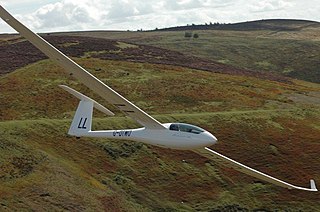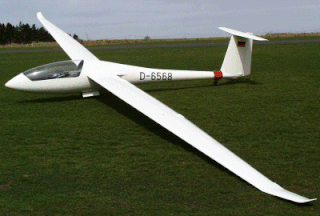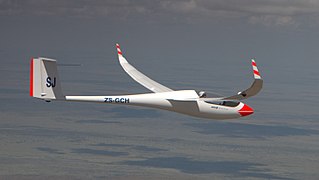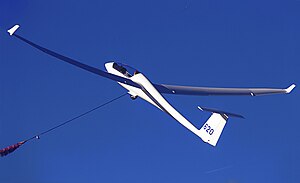
The Schempp-Hirth Discus is a Standard Class glider designed by Schempp-Hirth. It was produced in Germany between 1984 and 1995 but has continued in production in the Czech Republic. It replaced the Standard Cirrus. It was designed by Klaus Holighaus.

The Schempp-Hirth Discus-2 is a Standard Class sailplane produced by Schempp-Hirth since 1998. It replaced the highly successful Schempp-Hirth Discus.

The Schempp-Hirth Ventus is a sailplane produced during 1980–1994 by Schempp-Hirth, a German sailplane manufacturer. It was designed by Klaus Holighaus and replaced the Schempp-Hirth Mini-Nimbus. Schempp-Hirth manufactured 613 Ventus sailplanes.

The Schempp-Hirth Duo Discus is a high-performance two-seat glider primarily designed for fast cross-country flying, including gliding competitions. Often, it is used for advanced training.

The Schempp-Hirth Mini Nimbus is a 15 Metre-class glider designed and built by Schempp-Hirth GmbH in the late 1970s.
The Schempp-Hirth HS-3 Nimbus was a prototype glider built by Klaus Holighaus.

The Schempp-Hirth Nimbus-2 is an Open Class glider built by Schempp-Hirth during the 1970s. The Nimbus-2 first flew in April 1971 and a total of over 240 examples of all subtypes have been built until the beginning of the 1980s. It replaced the Schempp-Hirth Cirrus.

The Schempp-Hirth Nimbus 3 is a glider built by Schempp-Hirth.

The Rolladen-Schneider LS9 is an 18 metre single-seat motor glider launched in 2000 by Rolladen-Schneider. Production ended after just 10 gliders were built, when Rolladen-Schneider went into receivership.

The ASW 28 is a Standard Class glider with a fifteen-metre span built of modern fibre reinforced composites. The manufacturer of the ASW-28 is Alexander Schleicher GmbH & Co. The 'W' indicates this is a design of the influential and prolific German designer Gerhard Waibel. Serial production started in 2000.

HpH 304 is a family of sailplanes ranging from a single-seat composite 15 metre Class to a two-place 20 metre Open Class manufactured by the Czech company HpH Ltd. The sailplane was derived from a glider made by Glasflügel between 1980 and 1982 that was put back in production by HpH and who have modified it substantially and developed new models since.

The ASW 19 is a single-seat glider built by Alexander Schleicher GmbH & Co, first flying in 1975. It was originally designed as a Standard Class glider, but now mainly competes in the Club Class. The ASW 19 is known for its pleasant handling and some clubs use it as a training glider. It was succeeded by the all-new Schleicher ASW 24.

The G102 Astir is a single-seat glassfibre Club Class sailplane, designed by Burkhart Grob and built by Grob Aircraft. It was the first Grob-designed sailplane, with the first flight in December 1974. Grob had previously built the Schempp-Hirth Standard Cirrus under licence.

|} The Jonker JS-1 Revelation is a glider built of glass-fibre, carbon fibre and Kevlar. It is available with an 18-metre span for the 18 metre class or a 21-metre span for the Open class. The manufacturer is Jonker Sailplanes of PotchefstroomSouth Africa, founded in 2004 by two brothers, Attie and Uys Jonker. The structural and chief designer is Attie Jonker, while the airfoil and main aerodynamic features were developed by Johan Bosman in co-operation with the Delft University of Technology.

The Silent Club is a single seater sailplane of Italian manufacture. It is of the FAI type DU Class glider. It is sold by Alisport ready-to-fly or kit-built as pure glider or self-launching glider. The self-launching version is fitted with a single-blade propeller belt-driven by a two-stroke engine or optionally by an electric motor.

The Schleicher ASK 18 is a single-seat sailplane that was built by the German manufacturer Alexander Schleicher GmbH & Co. It was designed to be a sturdy aircraft for inexperienced solo pilots and so uses a simple and rugged construction and has docile handling characteristics.

The Grob G104 Speed Astir was a competition sailplane produced in Germany in the late 1970s as Grob's first design in the 15 metre class.

The Allstar SZD-54 Perkoz is a two-seater, glider for training, aerobatics, cross country flight and cloud flying from the Polish manufacturer Allstar PZL Glider. The sailplane has exchangeable wing tips for either 17.5 or 20 metres and is manufactured primarily from glass fibre reinforced plastic (GFRP). Without wing extension, it is certified for unlimited aerobatic manoeuvres. For glider training, the short wingspan is supplemented with winglets. As a cross-country glider with a 20 metres wing and winglets, the Perkoz has a glider index of 102. The SZD-54-2 Perkoz is the successor of the widely used SZD-50-3 Puchacz trainer, which is part of the SZD family of aircraft.

The Schempp-Hirth Ventus-3 is a sailplane produced by Schempp-Hirth. It replaces the highly successful Schempp-Hirth Ventus-2.

The Schleicher AS 34Me is a German glider manufactured by Alexander Schleicher. It is a self-launcher that uses an electrical propulsion system.



















